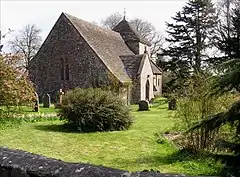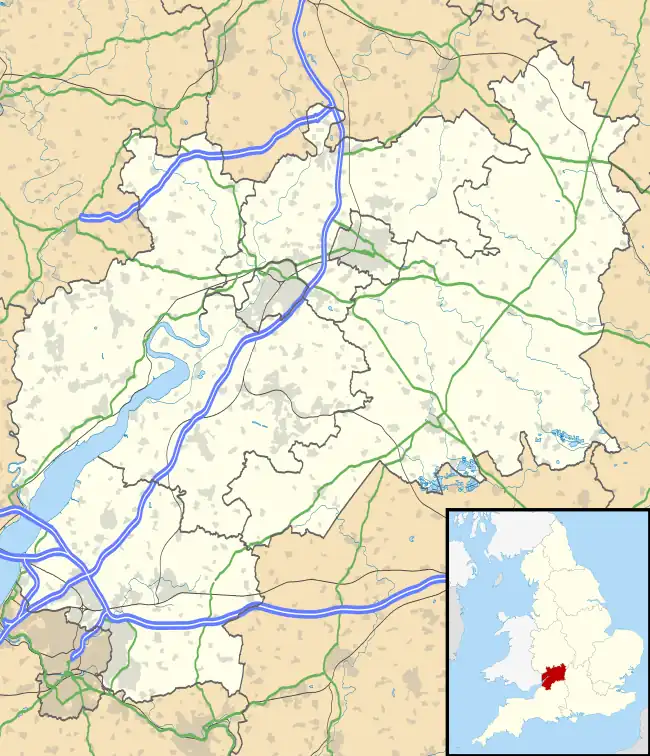Hewelsfield
Hewelsfield is a village in Hewelsfield and Brockweir civil parish, in the Forest of Dean district of Gloucestershire, England.
| Hewelsfield | |
|---|---|
 Hewelsfield Parish Church | |
 Hewelsfield Location within Gloucestershire | |
| OS grid reference | SO567020 |
| Civil parish | |
| District | |
| Shire county | |
| Region | |
| Country | England |
| Sovereign state | United Kingdom |
| Post town | Lydney |
| Postcode district | GL15 |
| Police | Gloucestershire |
| Fire | Gloucestershire |
| Ambulance | South Western |
| UK Parliament | |
The village is located 6 miles south of Coleford and 5 miles north-east of Chepstow, close to the Wye valley and partly within an Area of Outstanding Natural Beauty.
History
The area was known in the Anglo-Saxon period as Hiwoldestone. It was included by William the Conqueror in the Royal Forest of Dean, but by the 12th century was established as a village, with a church. Ancient routes running up from the River Severn at Alvington and Woolaston met at Hewelsfield village and continued to the nearby village of St. Briavels. In 1266 the manor of Hewelsfield was granted to Tintern Abbey, which retained it until the Dissolution in 1536. Together with the abbey grange at Brockweir, the manor was then granted to Henry Somerset, 2nd Earl of Worcester.[1][2]
There is evidence of a small castle motte close to the church, and earthworks close to the castle suggest either a deserted medieval village or field boundaries. A separate ancient field system exists close to Hewelsfield Court.[2]
The village was designated a Conservation Area in 1990.[2]
Church of St. Mary Magdalen
The parish church of St. Mary Magdalen has a Norman nave; an Early English chancel (restored in the 19th century); and a north transept enlarged in the 16th century.[3] The churchyard is circular in form, which is often taken to suggest a pagan site or Celtic foundation.[4]
Hewelsfield Common
The area known as Hewelsfield Common, west of the village and sloping down to the River Wye, was occupied and developed in a piecemeal fashion by squatters in the 18th and early 19th centuries. Later in the 19th century, encouraged partly by the opening of the Wye Valley Railway on the Monmouthshire side of the river in 1876, private residents and retired people settled in the area and enlarged the cottages or built new houses.[1]
Village Community Shop
Hewelsfield, together with Brockweir, is served by the Brockweir and Hewelsfield Village Shop and Café, a non-profit making community enterprise, staffed by volunteers from the local community.
Listed buildings in Hewelsfield
Listed buildings in the village of Hewelsfield are listed in the tables below, with links to the relevant Historic England list entry. Listed buildings in the village Brockweir are given in the Wikipedia article on Brockweir. For the purposes of the tables, 'Hewelsfield' is taken to include all buildings in the Civil Parish of Hewelsfield and Brockweir to the east of Offa's Dyke; 'Brockweir' is taken to include all buildings in the Civil Parish of Hewelsfield and Brockweir to the west of Offa's Dyke.
| Building name | List Entry Number | Grade |
|---|---|---|
| Church of St Mary Magdalen | 1186584 | II* |
| Boundary Wall, Lych Gate and Stiles to Churchyard to Church of St Mary Magdalen | 1323151 | II |
| Hewelsfield Court | 1186589 | II |
| Barn Attached to North West Corner of Hewelsfield Court | 1121555 | II |
| Barn About 35 metres West of Hewelsfield Court | 1299143 | II |
| Touchway Barn | 1186676 | II |
| Pair of Lime Kilns in Hewelsfield Cliff Wood | 1186594 | II |
| Milestone at Grid Reference 562028 | 1121517 | II |
| Building name | List Entry Number | Grade |
|---|---|---|
| Monument to Dinah Man in the Churchyard About 7 metres South East of the Porch to the Church of St Mary Magdalen | 1120785 | II |
| Unidentified Monument in the Churchyard About 11 metres South of the Nave of the Church of St Mary Magdalen | 1120790 | II |
| Unidentified Monument in the Churchyard About 11 metres South of the Tower to the Church of St Mary Magdalen | 1120797 | II |
| Monument to John Phillips in the Churchyard About 8 metres South of the Priest's Door to the Chancel of the Church of St Mary Magdalen | 1121146 | II |
| Unidentified Monument in the Churchyard About 12 1/2 metres South of the South East Corner of the Chancel to the Church of St Mary Magdalen | 1121548 | II |
| Unidentified Monument in the Churchyard About 5 metres South East of the Porch to the Churchyard of St Mary Magdalen | 1186585 | II |
| Unidentified Monument in the Churchyard About 8 metres South of the Nave to the Church of St Mary Magdalen | 1186586 | II |
| Monument to Wife of George Geo--- in the Churchyard About 7 metres South of the Tower to the Church of St Mary Magdalen | 1186587 | II |
| Monument to Alexander Morley or Moyley in the Churchyard About 13 metres South of the Porch to the Church of St Mary Magdalen | 1186588 | II |
| Monument to Ann Pitcher in the Churchyard Circa 1 1/2 metres South of Nave Wall of the Church of St Mary Magdalen | 1249770 | II |
| Monument to Ann Pritchard in the Churchyard Circa 11 metres South of Chancel Wall to the Church of St Mary Magdalen | 1249771 | II |
| Monument to Arthur Pitcher in the Churchyard Circa 2 metres South of Nave Wall of the Church of St Mary Magdalen | 1263579 | II |
| Monument to John Jane in the Churchyard Circa 4 metres South of Chancel Wall to the Church of St Mary Magdalen | 1263580 | II |
| Monument to ---M Wade in the Churchyard About 2 metres South of Nave Wall of the Church of St Mary Magdalen | 1299140 | II |
| Monument to Henery ----- in the Churchyard About 11 metres South of the Nave to the Church of St Mary Magdalen | 1299141 | II |
| Monument to Son of John Jane in the Churchyard About 2 1/2 metres South of Chancel Wall to Church of St Mary Magdalen | 1299142 | II |
| Monument to Elizabeth Brown in the Churchyard About 2 1/2 metres South East of Porch to Church of St Mary Magdalen | 1323177 | II |
References
- Baggs, A P; Jurica, A R J. "'Hewelsfield and Brockweir', in A History of the County of Gloucester: Volume 5, Bledisloe Hundred, St. Briavels Hundred, the Forest of Dean, ed. C R J Currie and N M Herbert (London, 1996), pp. 150-159". British History Online. Institute of Historical Research. Retrieved 16 September 2019.
- Forest of Dean Council: Hewelsfield Character Appraisal (PDF). Forest of Dean District Council. January 2007. Retrieved 30 October 2019.
- "Church of St Mary Magdalen". Historic England. Historic England. Retrieved 30 October 2019.
- "Boundary wall, lych gate and stiles to churchyard to church of St Mary Magdalen". Historic England. Historic England. Retrieved 30 October 2019.